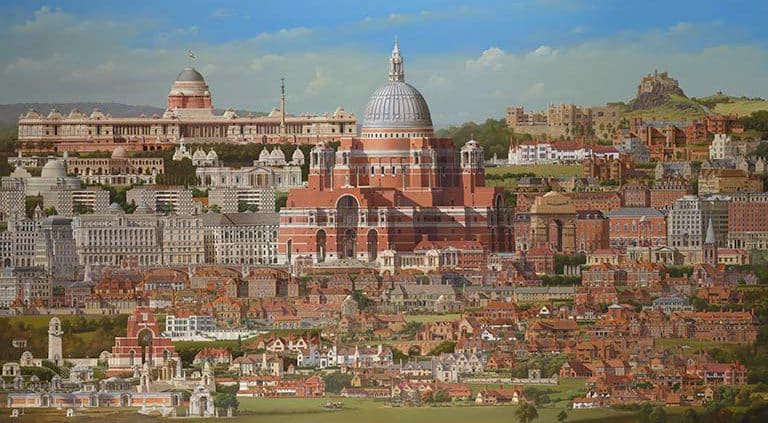Carl Laubin Honored at Driehaus Awards
Since 2003, the prestigious Richard H. Driehaus Prize at the University of Notre Dame has been awarded to a “living architect whose work embodies the highest ideals of traditional and classical architecture in contemporary society, and creates a positive cultural, environmental, and artistic impact.” Each year, the Henry Hope Reed Award recognizes a similar achievement of a person working outside the field of architecture. This year, for the first time, the Henry Hope Reed Award went to an artist – Carl Laubin. Admirers of Lutyens’s architecture know Carl Laubin’s work through his wonderful capriccio of 149 of Lutyens’s built and unbuilt works. All depicted at the same scale, the juxtaposition of the architectural designs richly illustrates the scope and variety of Sir Edwin’s work.
The Henry Hope Reed Prize was awarded in Chicago on March 23rd as part of the annual Driehaus Awards. The Lutyens Trust America and the Lutyens Trust in the UK were represented by Robin Prater, who found many Lutyens’s fans among the attendees. Events included a lovely reception at the University Club, an award presentation and lecture on Saturday morning, and a lavish dinner at the John B. Murphy Auditorium Saturday evening. The evening included a tour of the Driehaus Museum. This Gilded Age mansion has been saved twice from destruction, once by a group of 100 Chicago citizens in 1919 and more recently by Richard Driehaus, who sponsored its 2003-2008 restoration.
At the beginning of the Award Presentation, Richard Driehaus spoke in memoriam of David Watkin, a former Laureate. Both the 2019 Driehaus Prize winner, Maurice Culot, and Carl Laubin were then given a time to speak about their work. Maruice Culot was introduced by Leon Krier, while Carl Laubin was introduced by Demetri Porphyrios. Carl spoke eloquently about his work, referencing Lutyens in several instances and illustrating the value of painting in the interpretation of architecture. As Richard Driehaus summed it up, “With his stunningly detailed capricci, Carl Laubin has brought another dimension to the work of architects both past and present, allowing a glimpse into a beautiful world, sometimes real and sometimes imagined. Both Laubin and Culot have been instrumental in redefining classicism in a modern context.”

Presentation of 2019 Henry Hope Reed Prize
(L to R) Michael Lykoudis, Carl Laubin, Richard H. Driehaus

Carl Laubin’s Laureate Address


 Follow us on X
Follow us on X Follow us on Instagram
Follow us on Instagram Follow us on Facebook
Follow us on Facebook Follow us on YouTube
Follow us on YouTube

